
12 minute read
Evaluation of Biological Methanation for Power-to-Gas Applications
by IGU
By Frank Graf and Gerald Linke
x Figure 1. Germany has set a goal that by 2030, 30% of its gross final energy consumption and at least 50% of its power supply will be provided by renewable energy sources such as wind or solar energy. Nevertheless, these energies are fluctuating and intermittent and will need to be balanced for electric grid stability purposes. Furthermore, large storage capacities will be necessary to provide energy in periods with low production rates of renewable energy (especially in weak wind phases).
Electricity storage via Power-to-Gas (PtG) technology is a promising solution to tackle this issue. This process links the power grid with the gas grid by converting this surplus power into a grid compatible gas via a two-step process: H 2 production by water electrolysis and H 2 conversion with an external CO or CO 2 source to CH 4 via methanation. Both biological and catalytic methanation could be used for the methanation step. The coupling with biomass-based carbon sources is promising with respect to sustainability aspects and the decentralized production of renewable energy. The generated synthetic natural gas (SNG) can easily be injected into the existing gas distribution grid or gas storages, used as CNG fuel or utilized in all other well-established natural gas facilities.
In this article, the biological methanation connected with PtG processes will be evaluated technically and economically. Based on literature data and the authors’ own investigations, biological methanation concepts are compared with different thermochemical methanation technologies.
Technology and concepts for the application of biological methanation in PtG processes
In biological methanation (BM), a microorganism serves as a biocatalyst, converting H 2 and CO 2 into CH 4 . This process is operated between 40-70°C. Catalytic methanation (CM) finds its application for the methanation of CO and/or CO 2 . The reactors are typically operated at temperatures between 200-550°C and at pressures ranging from 1-100 bar. Both concepts have been known since the beginning of the 20th century (CM from 1902 and BM from 1906). While catalytic methanation was developed for various
Process flow diagram for biological methanation in a separate reactor
Overview of research groups and companies working on biological methanation (sorted by country in alphabetical order.
Institution Institute of Chemical Engineering, Division of Biochemical Engineering, Vienna University of Technology Department of Environmental Engineering, Technical University of Denmark Faculty of Environmental Science and Process Engineering, Brandenburg University of Technology Cottbus University of Mainz + Prüf-und Forschungsinstituts Pirmasens State Institute of Agricultural Engineering and Bioenergy, University of Hohenheim Krajete GmbH Electrochaea GmbH MicrobEnergy GmbH MicroPyros GmbH Concepts Separate reactor
In situ digester, separate reactor
Separate reactor
Separate reactor
In situ digester, separate reactor Separate reactor Separate reactor In situ digester, separate reactor Separate reactor Country Austria
Denmark
Germany
Germany
Germany Austria Germany, Denmark, USA Germany Germany
industrial applications (e.g. CO removal in ammonia production or the production of synthetic natural gas from coal), biological methanation was developed through R&D activities and has gained wide attention during recent years in connection with PtG concepts.
For BM two main process concepts are possible: methanation in situ in biogas digesters and methanation in a separate reactor. In a separate BM reactor, pure gases are converted by methanogen cultures into CH 4 (see Figure 1). This concept offers the possibility to increase the calorific value of raw biogas, but is not limited to biogas as a carbon source. Another advantage is that the process conditions and the reactor design can be adjusted with respect to the requirements of the hydrogenotrophic methanogens. Currently, several reactor concepts are being developed (e.g. fixed-bed, trickle-bed, membrane reactors).
Digesters of biogas plants can also be used for the PtG process chain (see Figure 2). In Europe about 15,000 plants already exist, revealing an overall PtG potential of about

Process flow diagram for in situ biological methanation
c Table 1.
x Figure 2.
v Table 2. 30 GW power input. Thereby, hydrogen is fed directly to the biogas digester. CO 2 produced by the digestion of biomass is then converted in situ to CH 4 resulting in a biogas with a higher methane content and calorific value. The methane formation rate of biological methanation is limited by the CO 2 production rate of the biogas plant. Furthermore, the process conditions cannot be adapted to optimal conditions for the biological methanation process. Nevertheless, no further reactor is necessary which results in a lower investment.
Both process concepts are the focus of academic research as well as the development of commercial applications. A selection is given in Table 1.
Technical evaluation of biological
To assess biological methanation different process engineering parameters and characteristics are analyzed and compared to catalytic methanation processes. A summary is given in Table 2.
Reactor size
The required reactor size is a crucial aspect regarding investment and operating costs (e.g. for stirring). A direct comparison of the required reactor volume is possible by comparing the Gas Hourly Space Velocity (GHSV). The GHSV is defined as the reactor volume divided by the volumetric feed gas flow (at standard temperature and pressure). In comparison to biological methanation, catalytic CO 2 methanation proceeds at a much faster rate. Hence, a biological methanation plant requires a reactor several orders of magnitude larger to convert a certain feed gas flow.
Tolerance of impurities
Biological methanation is very robust against impurities like H 2 S, O 2 or siloxanes that are present in CO 2 rich gases (e.g. biogas). In contrast to catalytic methanation the feed gas must not be cleaned upstream of the methanation reactor. This is a strong advantage of
methanation
biological methanation.
Process flexibility
For methanation to be operated dynamically as part of a PtG chain, both the minimum load and the load change rate need to be considered. Based on the available literature, all methanation concepts can be operated dynamically. It has been shown that the biology, the mass transfer, and/or the chemistry react very fast to load changes. Hence, the load change behaviour of a methanation plant is dominated
(continued on page 96)
Comparison of biological and catalytic methanation processes
Reactor type
Temperature in ˚C Pressure in bar Stage of development GHSV in h-1 * Tolerance of impurities Process flexibility Reaction heat utilization Electricity demand for processing Biological methanation Isothermal CSTR 40 – 70 1 – 10 Lab scale/pilot 1 – 100 High High Poor High
* GHSV which applies to a methane content in the product gas of > 90 vol.-% (dry basis) Catalytic methanation
300 – 350 > 5 Commercial 500 – 5,000 Low – Medium Medium Good – Very Good Low – Medium
Pilot and demonstration plants
During recent years numerous PtG demonstration projects have been realized. The first PtG pilot plant was probably the one built at the Tohoku Institute of Technology in Japan in 2003. The plant is relatively small, producing 1m³/h of methane (electrical power at electrolyzer < 10 kW).
The Audi e-gas plant in Wertle, Germany is the biggest PtG plant worldwide. Hydrogen is produced from three alkaline electrolyzers with a total electrical power of 6 MW. The CO 2 is provided by a biogas plant. Operation began in 2013. Cooled, fixed-bed catalytic methanation reactors are used.
A demonstration project for biological methanation was realized by the Viessmann Group. The 400 kW PtG plant consisting of a highpressure PEM electrolyzer connected to a high-pressure biological methanation reactor has been in operation at Allendorf in Germany since March 2015.
A pilot-scale plant built by PFI and based on a trickle bed reactor concept started operation in June 2015 at the Pirmasens-Winzeln Energy Park in Germany.
The BioCatProject aims to use the biological methanation developed by Electrochaea as part of the powerto-gas process chain. An alkaline electrolyser with an electrical power input of 1 MW will provide the hydrogen. At presstime the plant, which is located in Denmark, is undergoing commissioning and construction is scheduled to be complete by March 2016.
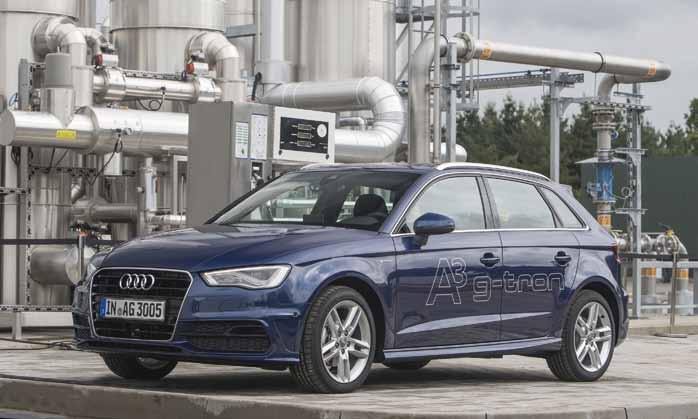
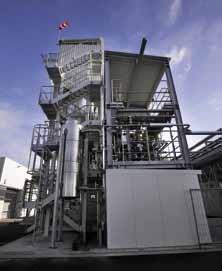
z The Audi e-gas plant is the largest in the
world to date. The plant’s methanation unit uses cooled, fixed-bed catalytic reactors.
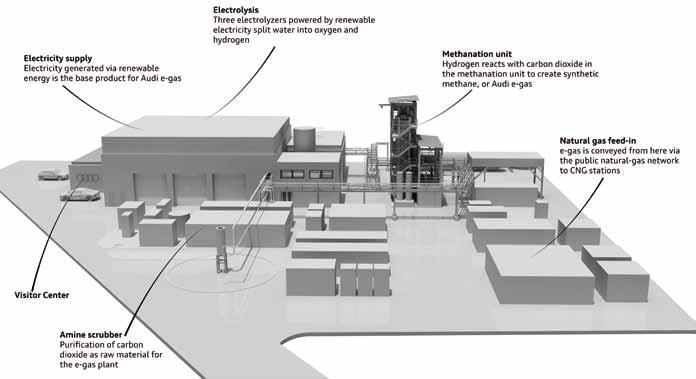
z An illustration of the elements that make
up the Audi e-gas plant.
c Viessmann Group’s biological methanation
demonstration project. The biogas it produces is fed into the gas grid.
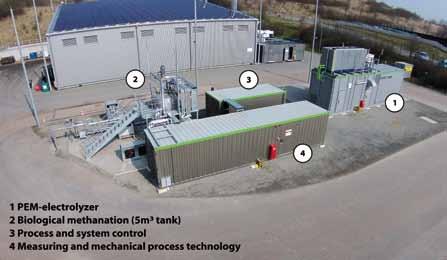
x Electrochaea’s BioCatProject in Denmark
is nearing completion.
c At the Audi plant’s inception, the e-gas
produced at Werlte was planned to power 1,500 Audi A3 Sportback g-tron vehicles for 15,000 kilometres of CO 2 -neutral driving every year. The vehicle’s engine can run on natural gas, biomethane and Audi e-gas as well as gasoline.
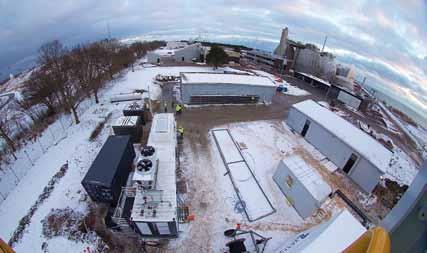
SNG production costs for different methanation concepts.
v Figure 3.
by the plant design and the peripheral equipment. For biological CO 2 methanation, it is reported that there is no minimum load based on biology. However, the operation of the plant is not reasonable if the energy consumption of the stirrer exceeds the energy content of the produced SNG (approximation: minimum load > 10%). Immediate load change from 100 to 0% can be realized with no negative effect on the biological methanation process. It was also demonstrated that a restart following 560 hours of stagnant operation was also possible without harmful consequences.
Reaction heat utilization
The reaction heat of the exothermal biological methanation reaction is released at low temperature levels between 30-60°C. Compared to catalytic methanation, where the reaction heat can be integrated in other processes (e.g.
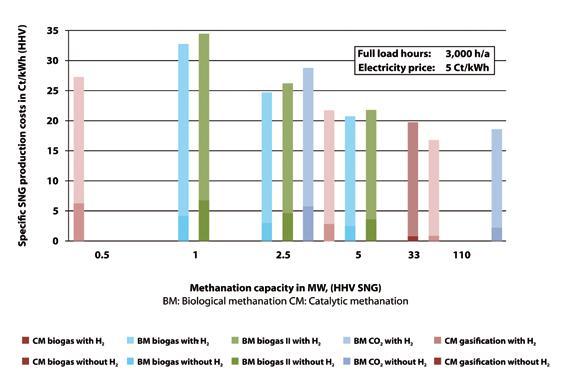
biogas upgrading), limited options to valorize the heat exist (e.g digester heating).
Electricity demand for processing
Because of the process conditions and requirements (limited mass transfer of hydrogen in liquid phase) the electricity demand of biological methanation reactors is very high compared to catalytic methanation. For the stirring systems, relevant power input is necessary.
In combination with the aforementioned aspect of heat utilization possibilities, biological methanation processes are unfavourable compared to catalytic methanation concepts in terms of overall energy efficiency, e.g. coupling catalytic methanation with biomethane offers an overall energy efficiency (utilized energy streams – SNG, heat – related to electricity input for electrolysis and processing) of more than 80% whereas concepts
with biological methanation hardly reach 60%. Thus, one of the main challenges of biological methanation is the adequate and energy efficient stirring of a largescale biological reactor with respect to hydrogen supply.
The economics of biological methanation
It is also interesting to compare the costs for biological methanation with catalytic methanation. Within two DVGW studies the generation costs for different catalytic and biological methanation processes and PtG concepts were examined. The economic evaluation was done in cooperation with companies offering methanation technologies. Thereby, basic engineering for different process chains and plant sizes was performed. The SNG costs were calculated based on the investment costs, the full load hours and the electricity price.
The generation costs for SNG strongly depend on the annual operational time and the electricity price. For economic feasibility, relevant annual operational times and low electricity costs are obligatory. For low full load hours, the CAPEX for the electrolysis is dominant, for larger full load hours, the electricity price is the most important parameter influencing the economics. In Figure 3 an example is given for different methanation concepts and plant sizes. It can be stated that the share of the hydrogen production costs is dominant compared to the additional costs for the methanation process. For large scale applications catalytic methanation is advantageous. The micro-economic evaluation shows that SNG is not yet competitive to biomethane.
For economic feasibility, different business cases such as mobility, balancing services and CO 2 certificates have to be combined. With respect to macro-economic considerations, it has to be taken into account that PtG can contribute to minimizing the expansion of electricity grid infrastructure and increasing the share of renewable energy in the transport and heating sectors. Therefore, PtG can play a major role in the realization of the ambitious conversion of the energy system.
Conclusions
The PtG process is a promising way to transform electricity from renewable energy sources and store it as chemical energy carriers. The methanation reaction can be performed in biological and thermochemical reactors. Biological methanation is an attractive option for impure CO 2 sources and small- and medium-sized plants. The biggest challenges lie in the optimization of the reactor design especially in context with the minimization of the necessary process energy and in the increase of overall energy efficiency. DVGW promotes the technology through its own research activities in process development and energy system integration.
Frank Graf is a Department Head at the DVGW-Research Centre at the EnglerBunte-Institut of the Karlsruhe Institute of Technology. Gerald Linke is Managing Director of DVGW, IGU Executive Committee Member and Chair of the R&D and Innovation Committee.
References
Techno-ökonomische Studie zur biologischen
Methanisierung bei Power-to-Gas
Konzepten, DVGW project, 2014 (www. dvgw-innovation.de). Techno-ökonomische Studie von Power-to
Gas-Konzepten, DVGW project, 2014 (www.dvgw-innovation.de). Götz, M., Graf, F., McDaniel Koch, A.,
Lefebvre, J., Bajohr, S., Kolb, T. “Coupling of Biomass Based Processes with PtG”,
Proceedings of the 26th World Gas
Conference, Paris, 2015.
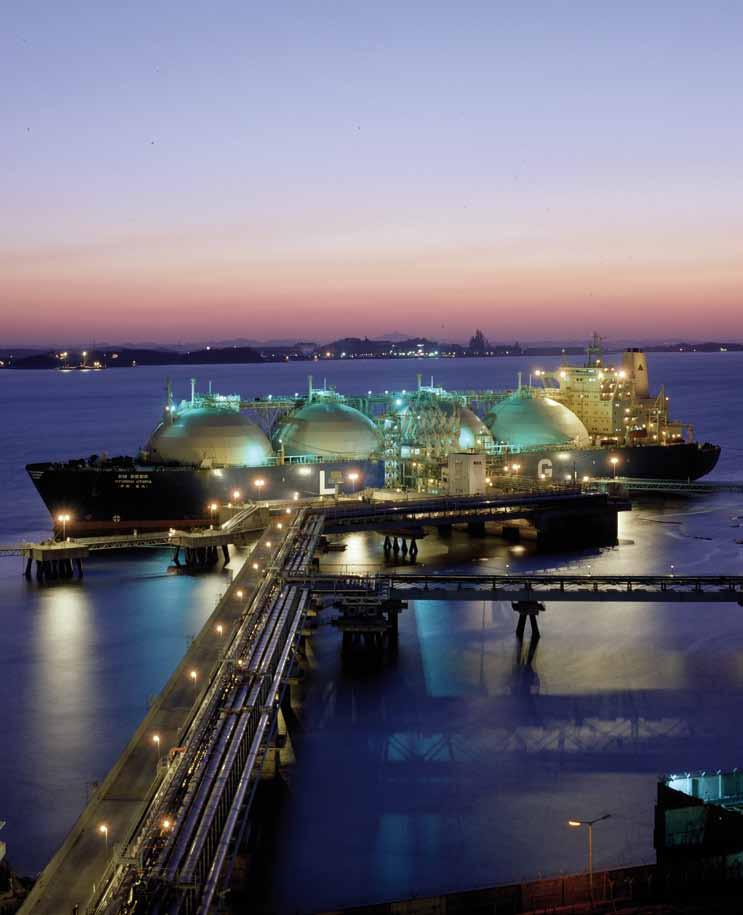
Features
This issue’s features section has two main themes. Following the successful conclusion of last December’s COP 21 summit that resulted in the Paris Agreement we lead with an article discussing the opportunities and challenges the agreement presents to the natural gas industry in a carbon-constrained future. Closely tied to this we look at IGU’s research report Case Studies in Improving Urban Air Quality that was launched on the sidelines of the meeting. In an increasingly urbanized world, when set against other fossil fuel sources, natural gas can have an important and beneficial impact on the health of billions.
The other main theme of the section is LNG. With LNG 18 almost upon us, bringing industry leaders and professionals from across the globe to Perth, we have two articles that set the stage. Firstly an overview of the state of the industry and how it has changed since Perth last played host to the LNG X conferences with LNG 12 in 1998. Secondly a focus on the important LNG developments underway in Australia and the United States and the ramifications these will have on the future of the market. In conclusion the LNG 18 coordination committee outlines the event itself.
We follow with two articles from IGU’s affiliated organisations. Continuing the LNG theme, the International Group of Liquefied Natural Gas Importers (GIIGNL) outlines its history, then the International Pipe Line and Offshore Contractors Association (IPLOCA) celebrates its 50 years of service to the industry.
We close with an introduction to the three newest members of IGU.










